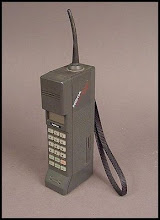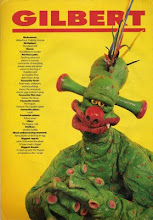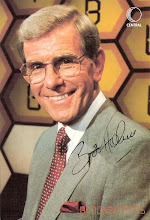 Up until a couple of months ago, many of you wouldn't have seen "Tiswas" because it wasn't fully networked...
Up until a couple of months ago, many of you wouldn't have seen "Tiswas" because it wasn't fully networked...
Back to the Look-In which took us into 1980, and Tiswas was becoming more widespread. However, if you look at the ITV programmes this week page further down this post, you will see that a few channels, including Tyne Tees, still seemed to be lacking the show!
 Ed "Stewpot" Stewart was well-known as a radio DJ and TV personality and his Newsdesk feature ran in Look-In for some years. My main memory of Mr Stewart is of him trilling "Morning!" in a high pitched voice. This was his catchphrase and was very zany indeed.
Ed "Stewpot" Stewart was well-known as a radio DJ and TV personality and his Newsdesk feature ran in Look-In for some years. My main memory of Mr Stewart is of him trilling "Morning!" in a high pitched voice. This was his catchphrase and was very zany indeed. Gypsy Rose Stewart predicated many things for the 1980s - including the possibility of a robot pop idol, exciting developments if "CBR" (CB radio) became legal, televisions that slid down from the ceiling at the touch of a button, and more elaborate toys. LOOKING FORWARD TO THE EIGHTIES
'80s Actual has inserted a couple of interesting facts along the way!
This is my first Newsdesk of 1980 and I wish a happy new year to "Look-in" readers. And not only that, a happy new decade, too. The next ten years look like being the most exciting the world has ever known, so let's take a look at some of the changes we can expect.
First the box - or "the slab" as television sets will be called. That familiar cube shape will begin to disappear from our living rooms in the 80s, to be replaced by large, thin screens which will slide from the ceiling at the press of a button. At the viewer's finger-tips will be a console, splattered with buttons and knobs from which hundreds of programmes from all round the world can be summoned. Programmes will be more lavish and spectacular, too, as more and more countries combine their skills and resources in multi-national co-productions.
Sets will combine video-recording units, so you can record as you go, and "freeze frame" or control your own "action replays" [Only 5% of UK households had VCRs in 1980, rising to nearly 20% in 1983]. More sets will also supply a vast selection of up-to-the-minute news, sports results, weather forecasts and so on, in printed form, as is happening already with systems like Oracle [Teletext services were slow to catch on - only 6% of UK homes had Oracle and Ceefax in 1984]. And, by the end of the decade, you could be shopping by TV. You'll get a list of goods and prices at your local super-colossal-supermarket and, with the press of a switch or two, you'll make your selection and arrange delivery to your door. You won't collect shopping yourself because someone may be using the communal transporter! Individual cars may be on the way out by 1990. So look after your bike, it may have to last a lifetime.
POP GOES THE POP STAR
Pop will change too. Video discs will become more popular as more people get the machinery to play them, heralding a new era in hi-fi. No sound system will be complete unless you can watch the artists - via the "slab" again - whilst listening to them "multi-phonetically",. And musical instruments will change, too. They may replace the human voice in some cases. Micro-chips are already producing the human voice in toys and computers, so the 1980s may produce the first robot pop idol. Yes, record producers will be able to combine the qualities of the best pop singers in the world into one robot singer. And he, I mean it, will be backed by a group of robots playing advanced synthesisers. I don't really fancy that idea. If singers can be replaced by robots - what about disc jockeys?
Radios? Well, they will become smaller and more powerful, with tiny wrist-watch receivers incorporating tape recorders, and perhaps even transmitters. That is, if CBR - Citizen [sic] Band Radio [Invented by American Al Gross in the 1940s] - becomes legal in Britain, as it is in America. That way you can chat with your friends, whether they are at home, in the car or generally out and about.
Sport will change, possibly in an inscrutable way. China has just been admitted to the Olympic Games and the television companies will be concentrating on their activities. Whatever happens, one thing is to be hoped for: that their good sportsmanship will influence others. The Chinese are tremendously well-behaved as a rule, and show good manners and respect for their opponents and spectators. They could be an example to follow.
Other pastimes will become more mechanised. We already have gadgets that can beat you at noughts and crosses and chess, and dolls that answer you back when they're told off. Next could be toy soldiers who shoot back at you - what a nightmare if that happened! Whatever occurs, toys will become more elaborate. Soon you won't play with them, you'll just switch them on and they'll perform for you. Many people think this could be a bad trend, though, because it stops youngsters from using their imaginations.
But you will probably have to use your imagination to tell the difference between boys and girls in the 1980s because fashion trends are pointing towards everyone wearing the same gear. Light, comfortable, all-weather clothes are being developed to be worn by both sexes. A pity in a way, because that might mean fewer pretty dresses around to brighten up the scene... unless the boys wear them, which might be a post-Punk craze. What a drag that would be!
Well, that's only a tiny selection of things to look forward to - both good and bad - in the 80s. Whatever you think about it, one thing is certain, it won't be dull!
 BBC radio DJ Pete Murray is the Star Snap. Do you remember Pete Murray's Open House with its "bing-bong" doorbell theme tune?
BBC radio DJ Pete Murray is the Star Snap. Do you remember Pete Murray's Open House with its "bing-bong" doorbell theme tune?
 Blow a big bubble - win a music centre! The Look-In contained a free bubble measurer - and also an apology for an increase in the cost of the magazine. With quality freebies galore, who could grumble?
Blow a big bubble - win a music centre! The Look-In contained a free bubble measurer - and also an apology for an increase in the cost of the magazine. With quality freebies galore, who could grumble?
 "You put an 'O' after 'W'..." - Worzel's Song charted in March 1980, but sadly only reached No 33.
"You put an 'O' after 'W'..." - Worzel's Song charted in March 1980, but sadly only reached No 33.
From the Look-In feature, we learned some of the behind the scenes facts about life at Scatterbrook Farm.
Filming of the series had been delayed by the 1979 ITV strike, which had led to certain difficulties - not least an increase in the presence of mud! The preferred recording season was summer, but autumn had to suffice and Jon Pertwee said: "There was so little time left we couldn't afford to worry about the weather and the difficulties of shooting out of doors at that time of year."
Jeremy Austin, who played John Peters, had become an avid fan of the original Barbara Euphan Todd Worzel Gummidge books.
Charlotte Coleman, who played John's sister, Sue, said of the show's leading man: "Jon's not a bit like I expected him to be. I thought he might be like Dr Who, but he was completely different. He wasn't hoitytoity, or anything like that. I was very shy with him at first, but once I'd got to know him I was all right."
 Debbie Harry - the divine front woman from Blondie, was the pin-up. Having first hit the UK pop charts with Denis in February 1978, Blondie became one of the top groups of the last couple of years of the 1970s and the first couple of years of the 1980s - the group truly straddled the two decades!
Debbie Harry - the divine front woman from Blondie, was the pin-up. Having first hit the UK pop charts with Denis in February 1978, Blondie became one of the top groups of the last couple of years of the 1970s and the first couple of years of the 1980s - the group truly straddled the two decades!
From the Look-In feature on the band:
Something which seemed to surprise the American audience was that Blondie was the name of the whole group and not the name of Debbie Harry. Stories have come back from America about the band being upset by the confusion, and Clem [Burke] explained what the problem was.
"In the beginning there was an identification problem - but I suppose it was our own fault for calling the band Blondie. It's not that we mind if people want to speak to Debbie, but I don't like it when people speak to me but don't really know who they are talking to. We all want to be recognised for what we are and what we are doing."
Must admit, I had trouble associating the Blondie title with the whole band.
 Language school based sitcom Mind Your Language originally ran from 1977 to 1979 and was one of the picture strips featured in Look-In during its time. Considered racist by some, the show was dropped, but brought back by an independent company called Tri Films in the mid-1980s and produced by Albert Moses, who played one of the foreign students. This final series was not networked.
Language school based sitcom Mind Your Language originally ran from 1977 to 1979 and was one of the picture strips featured in Look-In during its time. Considered racist by some, the show was dropped, but brought back by an independent company called Tri Films in the mid-1980s and produced by Albert Moses, who played one of the foreign students. This final series was not networked.
Other featured comic strips in the Look-In which took us into the 1980s included The Benny Hill Page and Sapphire and Steel.
 Worzel Gummidge - Jon Pertwee, starred on the cover of the Look-In which took us into the 1980s. The Southern TV children's series had begun in 1979, but Worzel had actually been around since the 1930s, when Barbara Euphan Todd's first book about the comical and lovable scarecrow was published.
Worzel Gummidge - Jon Pertwee, starred on the cover of the Look-In which took us into the 1980s. The Southern TV children's series had begun in 1979, but Worzel had actually been around since the 1930s, when Barbara Euphan Todd's first book about the comical and lovable scarecrow was published. A brief diversion to the Daily Mirror, 5 August 1980.
A brief diversion to the Daily Mirror, 5 August 1980. Up until a couple of months ago, many of you wouldn't have seen "Tiswas" because it wasn't fully networked...
Up until a couple of months ago, many of you wouldn't have seen "Tiswas" because it wasn't fully networked... Ed "Stewpot" Stewart was well-known as a radio DJ and TV personality and his Newsdesk feature ran in Look-In for some years. My main memory of Mr Stewart is of him trilling "Morning!" in a high pitched voice. This was his catchphrase and was very zany indeed.
Ed "Stewpot" Stewart was well-known as a radio DJ and TV personality and his Newsdesk feature ran in Look-In for some years. My main memory of Mr Stewart is of him trilling "Morning!" in a high pitched voice. This was his catchphrase and was very zany indeed.  BBC radio DJ Pete Murray is the Star Snap. Do you remember Pete Murray's Open House with its "bing-bong" doorbell theme tune?
BBC radio DJ Pete Murray is the Star Snap. Do you remember Pete Murray's Open House with its "bing-bong" doorbell theme tune? Blow a big bubble - win a music centre! The Look-In contained a free bubble measurer - and also an apology for an increase in the cost of the magazine. With quality freebies galore, who could grumble?
Blow a big bubble - win a music centre! The Look-In contained a free bubble measurer - and also an apology for an increase in the cost of the magazine. With quality freebies galore, who could grumble? "You put an 'O' after 'W'..." - Worzel's Song charted in March 1980, but sadly only reached No 33.
"You put an 'O' after 'W'..." - Worzel's Song charted in March 1980, but sadly only reached No 33. Debbie Harry - the divine front woman from Blondie, was the pin-up. Having first hit the UK pop charts with Denis in February 1978, Blondie became one of the top groups of the last couple of years of the 1970s and the first couple of years of the 1980s - the group truly straddled the two decades!
Debbie Harry - the divine front woman from Blondie, was the pin-up. Having first hit the UK pop charts with Denis in February 1978, Blondie became one of the top groups of the last couple of years of the 1970s and the first couple of years of the 1980s - the group truly straddled the two decades! Language school based sitcom Mind Your Language originally ran from 1977 to 1979 and was one of the picture strips featured in Look-In during its time. Considered racist by some, the show was dropped, but brought back by an independent company called Tri Films in the mid-1980s and produced by Albert Moses, who played one of the foreign students. This final series was not networked.
Language school based sitcom Mind Your Language originally ran from 1977 to 1979 and was one of the picture strips featured in Look-In during its time. Considered racist by some, the show was dropped, but brought back by an independent company called Tri Films in the mid-1980s and produced by Albert Moses, who played one of the foreign students. This final series was not networked.  What ITV goodies did Look-In recommend? Well, amongst others, were Magpie, Mr and Mrs, Crossroads, Robin's Nest and Emmerdale Farm! Some of the ITV companies listed here wouldn't make it very far into the new decade. See here for more details.
What ITV goodies did Look-In recommend? Well, amongst others, were Magpie, Mr and Mrs, Crossroads, Robin's Nest and Emmerdale Farm! Some of the ITV companies listed here wouldn't make it very far into the new decade. See here for more details. 














2 comments:
A wonderful article that has brought back vivid memories of the 1980's - thank you!
Glad you enjoyed it! :)
Post a Comment